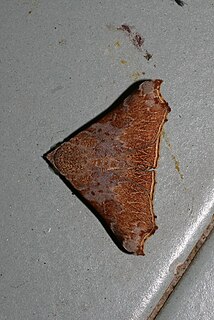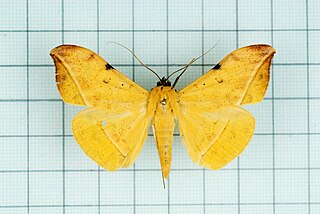Related Research Articles
Abriesa is a monotypic moth genus of the family Erebidae. Its only species, Abriesa derna, is found in Queensland, Australia. Both the genus and the species were first described by Charles Swinhoe in 1900.
Uncula is a genus of moths of the family Noctuidae. The genus was described by Charles Swinhoe in 1900.
Carsina is a genus of moths of the family Erebidae. The genus was erected by George Hampson in 1924.

Chilkasa is a monotypic moth genus in the family Erebidae. Its only species, Chilkasa falcata, is found in India, Thailand, Peninsular Malaysia, Sumatra, Borneo and the Philippines. Both the genus and the species were first described by Swinhoe in 1885.

Cidariplura is a genus of moths of the family Erebidae. The genus was erected by Arthur Gardiner Butler in 1879.
Eucosmocara is a monotypic moth genus of the family Erebidae. Its only species, Eucosmocara plumifera, is known from Borneo. Both the genus and the species were first described by Charles Swinhoe in 1901.

Gesonia is a genus of moths of the family Erebidae erected by Francis Walker in 1859.
Globosusa is a genus of moths of the family Erebidae. The genus was erected by Charles Swinhoe in 1918.

Goniophila is a genus of moths of the family Erebidae. The genus was erected by George Hampson in 1926.

Hamodes is a genus of moths of the family Erebidae. The genus was erected by Achille Guenée in 1852.
Hepsidera is a genus of moths of the family Erebidae. The genus was erected by Charles Swinhoe in 1902.
Mecodina is a genus of moths of the family Erebidae first described by Achille Guenée in 1852.
Metopta is a monotypic moth genus of the family Erebidae erected by Charles Swinhoe in 1900. Its only species, Metopta rectifasciata, was first described by Édouard Ménétries in 1863. It is found in Korea and Japan.
Oxaenanus is a genus of moths of the family Erebidae. The genus was erected by Charles Swinhoe in 1900.
Perata is a monotypic moth genus of the family Erebidae. Its only species, Perata curiosalis, is known from the Khasi Hills of Meghalaya, India. Both the genus and species were first described by Charles Swinhoe, the genus in 1919 and the species earlier in 1905.

Rivula is a genus of moths in the family Erebidae described by Achille Guenée in 1845.
Stenopaltis is a monotypic moth genus of the family Erebidae. Its only species, Stenopaltis lithina, is known from the Australian state of Queensland. Both the genus and the species were first described by Charles Swinhoe in 1901.
Trigonodesma is a monotypic moth genus of the family Erebidae. Its only species, Trigonodesma bimacula, is found in the Philippines. Both the genus and the species were first described by Wileman and South in 1921.
Oenospila is a genus of moths in the family Geometridae erected by Charles Swinhoe in 1892.
Vizaga is a genus of moths of the family Nolidae. The genus was erected by Charles Swinhoe in 1901.
References
- ↑ Savela, Markku (March 5, 2012). "Stadna Swinhoe, 1900". Lepidoptera and Some Other Life Forms. Retrieved February 10, 2020.
- ↑ Beccaloni, G.; Scoble, M.; Kitching, I.; Simonsen, T.; Robinson, G.; Pitkin, B.; Hine, A.; Lyal, C., eds. (2003). "Stadna". The Global Lepidoptera Names Index . Natural History Museum . Retrieved February 10, 2020.
- ↑ Pitkin, Brian & Jenkins, Paul (November 5, 2004). "Stadna Swinhoe, 1900". Butterflies and Moths of the World. Natural History Museum, London . Retrieved February 10, 2020.
| This Herminiinae article is a stub. You can help Wikipedia by expanding it. |